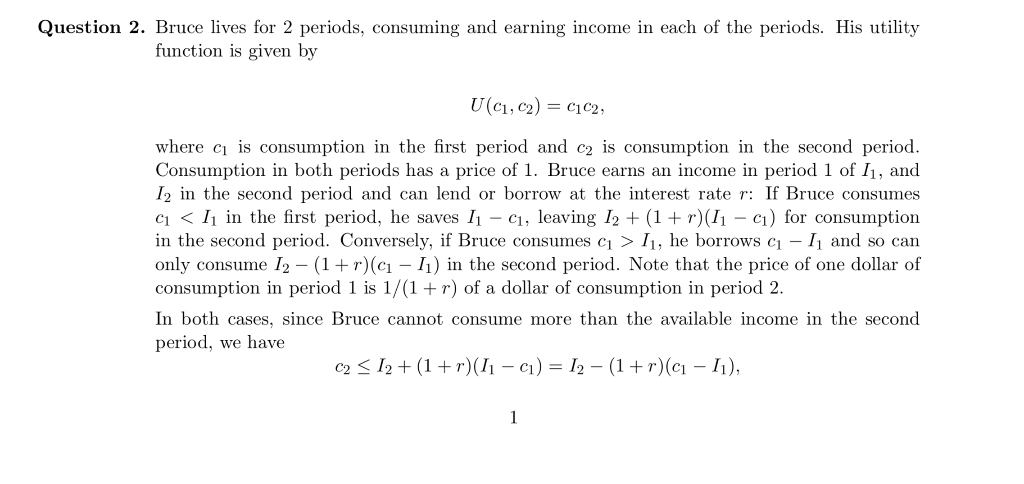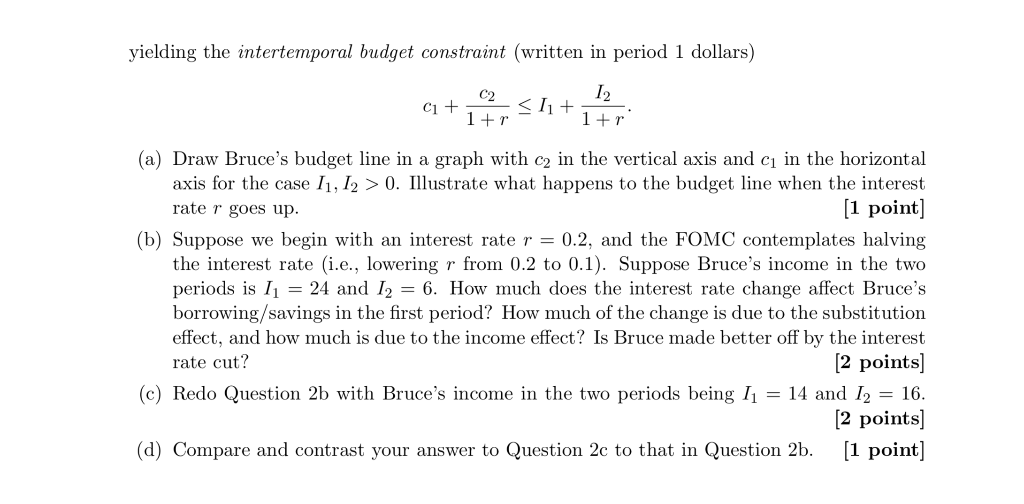

Question 2. Bruce lives for 2 periods, consuming and earning income in each of the periods. His utility function is given by U(C1, C2) = C102, where ci is consumption in the first period and c2 is consumption in the second period. Consumption in both periods has a price of 1. Bruce earns an income in period 1 of 11, and 12 in the second period and can lend or borrow at the interest rate r: If Bruce consumes c1 11, he borrows C1 11 and so can only consume 12 (1+r)(C1 11) in the second period. Note that the price of one dollar of consumption in period 1 is 1/(1+r) of a dollar of consumption in period 2. In both cases, since Bruce cannot consume more than the available income in the second period, we have C2 0. Illustrate what happens to the budget line when the interest rater goes up. [1 point] (b) Suppose we begin with an interest rate r = 0.2, and the FOMC contemplates halving the interest rate (i.e., lowering r from 0.2 to 0.1). Suppose Bruce's income in the two periods is 11 = 24 and 12 = 6. How much does the interest rate change affect Bruce's borrowing/savings in the first period? How much of the change is due to the substitution effect, and how much is due to the income effect? Is Bruce made better off by the interest rate cut? [2 points] (c) Redo Question 2b with Bruce's income in the two periods being 11 = 14 and 12 = 16. [2 points) (d) Compare and contrast your answer to Question 2c to that in Question 2b. [1 point] Question 2. Bruce lives for 2 periods, consuming and earning income in each of the periods. His utility function is given by U(C1, C2) = C102, where ci is consumption in the first period and c2 is consumption in the second period. Consumption in both periods has a price of 1. Bruce earns an income in period 1 of 11, and 12 in the second period and can lend or borrow at the interest rate r: If Bruce consumes c1 11, he borrows C1 11 and so can only consume 12 (1+r)(C1 11) in the second period. Note that the price of one dollar of consumption in period 1 is 1/(1+r) of a dollar of consumption in period 2. In both cases, since Bruce cannot consume more than the available income in the second period, we have C2 0. Illustrate what happens to the budget line when the interest rater goes up. [1 point] (b) Suppose we begin with an interest rate r = 0.2, and the FOMC contemplates halving the interest rate (i.e., lowering r from 0.2 to 0.1). Suppose Bruce's income in the two periods is 11 = 24 and 12 = 6. How much does the interest rate change affect Bruce's borrowing/savings in the first period? How much of the change is due to the substitution effect, and how much is due to the income effect? Is Bruce made better off by the interest rate cut? [2 points] (c) Redo Question 2b with Bruce's income in the two periods being 11 = 14 and 12 = 16. [2 points) (d) Compare and contrast your answer to Question 2c to that in Question 2b. [1 point]








